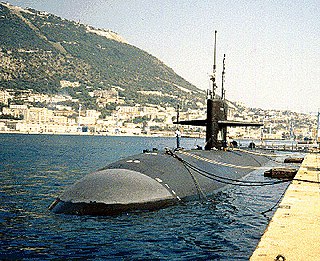
USS New York City (SSN-696) was a Los Angeles-class submarine and the only vessel of the United States Navy to be named specifically for New York City.

USS Seawolf (SSN-575) was the third ship of the United States Navy to be named for the seawolf, the second nuclear submarine, and the only US submarine built with a liquid metal cooled (sodium), beryllium-moderated nuclear reactor, the S2G. Her overall design was a variant of Nautilus, but with numerous detail changes, such as a conning tower, stepped sail, and the BQR-4 passive sonar mounted in the top portion of the bow instead of further below. This sonar arrangement resulted in an unusual bow shape above the water for a U.S. submarine. Originally laid down in 1953, her distinctive reactor was later replaced with a standard pressurized water reactor, the replacement process lasting from 12 December 1958 to 30 September 1960.

USS Skate (SSN-578) was the third submarine of the United States Navy named for the skate, a type of ray, was the lead ship of the Skate class of nuclear submarines. She was the third nuclear submarine commissioned, the first to make a completely submerged trans-Atlantic crossing, the second submarine to reach the North Pole, and the first to surface there.

USS Nautilus (SSN-571) was the world's first operational nuclear-powered submarine and the first submarine to complete a submerged transit of the North Pole on 3 August 1958. Her initial commanding officer was Eugene "Dennis" Wilkinson, a widely respected naval officer who set the stage for many of the protocols of today's Nuclear Navy of the US, and who had a storied career during military service and afterwards.
USS Tunny (SSN-682), a Sturgeon-class attack submarine, was the second submarine of the United States Navy to be named for the tunny, any of several oceanic fishes resembling the tuna.

USS Archerfish (SSN-678), a Sturgeon-class attack submarine, was the second ship of the United States Navy to be named for the archerfish, a family (Toxotidae) of fish notable for their habit of preying on insects and other animals by shooting them down with squirts of water from the mouth.

USS Tullibee (SSN-597), a unique submarine, was the second ship of the United States Navy to be named for the tullibee, any of several whitefishes of central and northern North America.

USS James K. Polk (SSBN-645), a Benjamin Franklin class fleet ballistic missile submarine, was the second ship of the United States Navy to be named for James K. Polk (1795–1849), the eleventh President of the United States (1845–1849). She was later converted into an attack submarine and redesignated SSN-645.

USS Skipjack (SSN-585), the lead ship of her class of nuclear-powered attack submarine, was the third ship of the United States Navy to be named after the skipjack tuna.

USS Whale (SSN-638) was a Sturgeon-class submarine nuclear-powered attack submarine of the United States Navy. She was the second ship of that name, after the whale family of aquatic mammals.

USS Sturgeon (SSN-637), was the lead ship of her class of nuclear-powered attack submarines. She was the third ship of the United States Navy to be named for the sturgeon.

USS Bergall (SSN-667), a Sturgeon-class attack submarine, was the second ship of the United States Navy to be named for the bergall, a small fish found along the Atlantic coast of North America from the Chesapeake Bay to Labrador.

USS Albuquerque (SSN-706) was a Los Angeles-class attack submarine of the United States Navy. She was the second U.S. warship to be named for Albuquerque, New Mexico. The contract to build her was awarded to the Electric Boat Division of General Dynamics Corporation in Groton, Connecticut, on 31 October 1973 and her keel was laid down on 27 December 1979. She was launched on 13 March 1982, sponsored by Nancy L. Domenici, and commissioned on 21 May 1983.

USS Trepang (SSN-674), a Sturgeon-class attack submarine, was the second ship of the United States Navy to be named for the trepang, Holothuroidea, a marine animal with a long, tough, muscular body.

USS Sunfish (SSN-649), a Sturgeon-class attack submarine, was the second ship of the United States Navy to be named for the ocean sunfish, a marine species having a deep body truncated behind, and high dorsal and anal fins.

USS Pargo (SSN-650), a Sturgeon-class attack submarine, was the second ship of the United States Navy to be named for the pargo, also known as the red snapper, a fish of the genus Lutjanus found in the West Indies.

USS Cavalla (SSN-684), a Sturgeon-class submarine, was the second ship of the United States Navy to be named for the cavalla, a salt water fish. Although it was a Sturgeon class design, Cavalla was a modified "long hull" boat, approximately 10 feet (3.0 m) longer than the earlier ships in its class.

USS Flying Fish (SSN-673), a Sturgeon-class attack submarine, was the third ship of the United States Navy to be named for the flying fish, any of number of fishes whose long winglike fins make it possible for them to move some distance through the air.

USS Groton (SSN-694), the seventh Los Angeles-class submarine, was the third ship of the United States Navy to be named for Groton, Connecticut. The contract to build her was awarded to the Electric Boat Division of General Dynamics Corporation in Groton, Connecticut on 31 January 1971 and her keel was laid down on 3 August 1973. She was launched on 9 October 1976 sponsored by Mrs. Anne Francis Richardson, wife of Secretary of Commerce Elliot L. Richardson, and commissioned on 8 July 1978, with Commander R. William Vogel, III in command and Master Chief Petty Officer Joseph Pow as Chief of the Boat.

USS Pasadena (SSN-752) is a Los Angeles-class submarine and the third ship of the United States Navy to be named for Pasadena, California.























